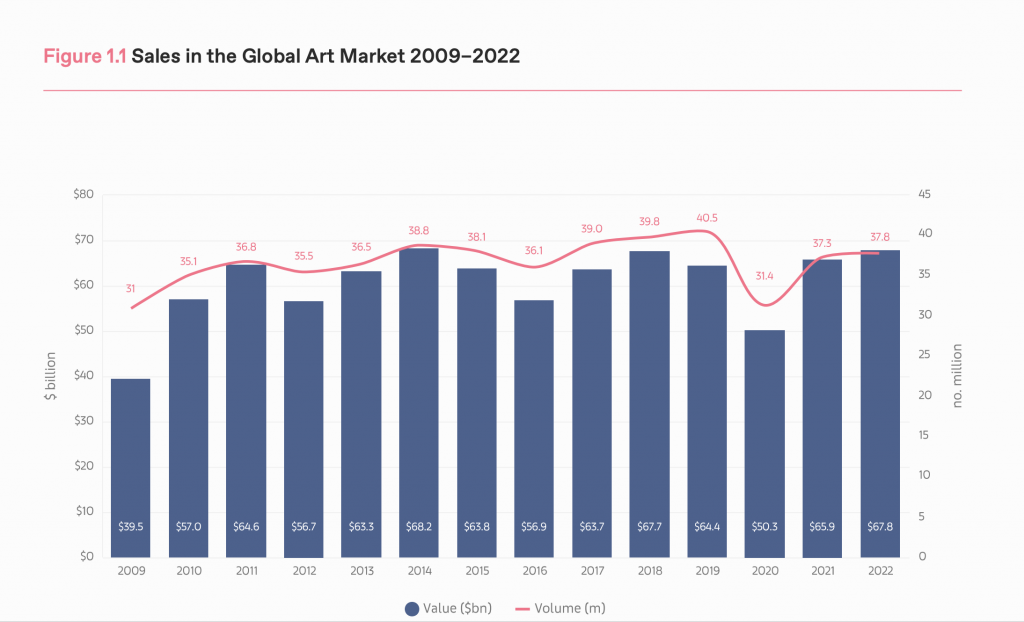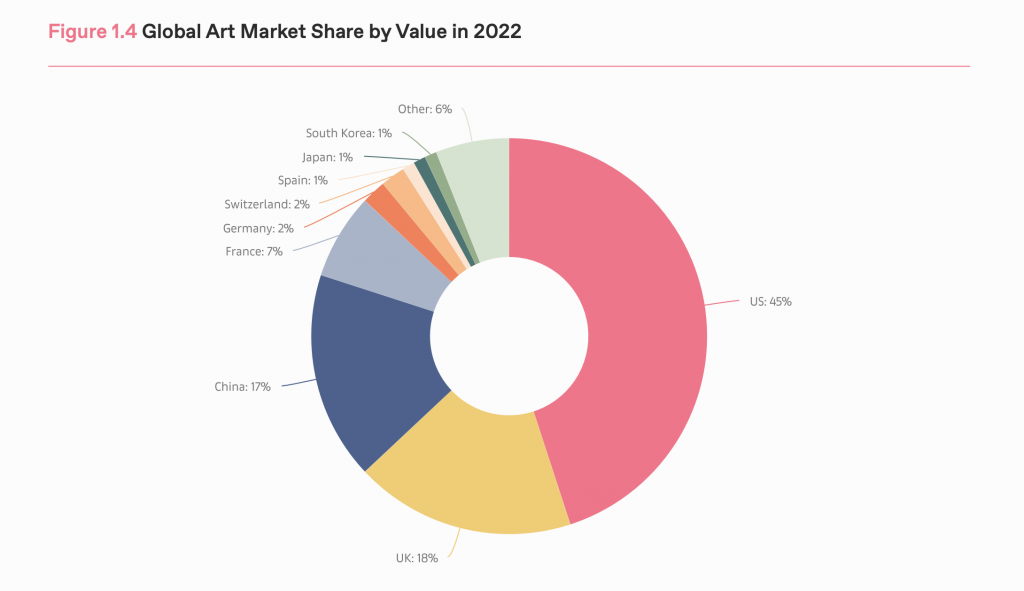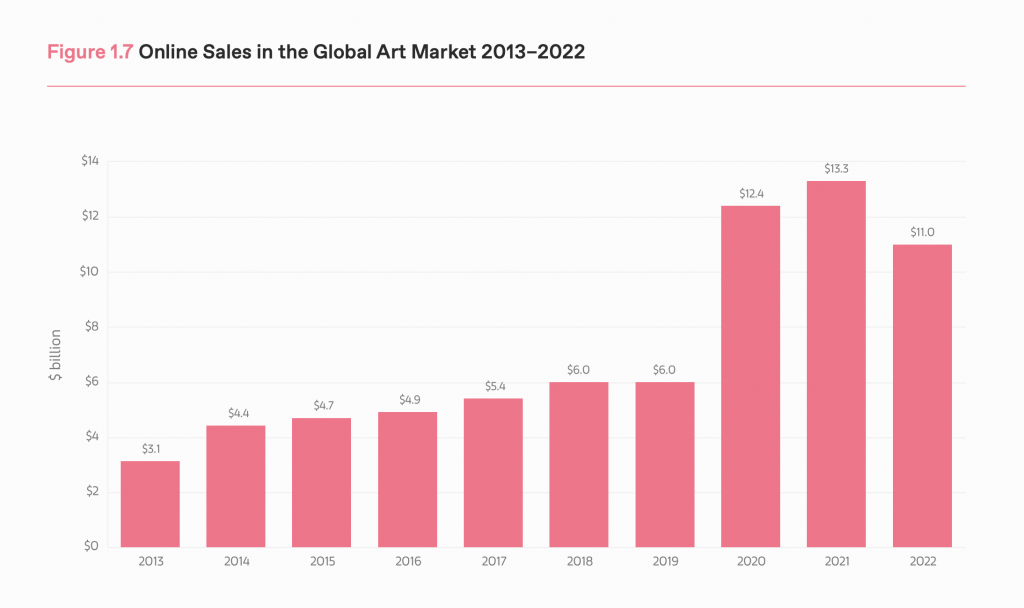There are a number of surprisingly upbeat conclusions about the global art market – and varying degrees of country-specific rebounds from the pandemic – in the latest UBS Art Basel report, authored by cultural economist Clare McAndrew.
The data shows that the US art market in particular has fared quite well, as has that of the UK – a fact that some might find surprising, given all the talk of related volatility and uncertainty. to Brexit in recent years – while the art market in China has been hit with lockdown pressures, including canceled sales and events.
According to Christl Novakovic’s comments, CEO of UBS Europe SE and Head of Wealth Management Europe, 2022 “saw the art market maintain its post-pandemic rebound and strengthen despite severe economic uncertainty and the return of war to Europe. Even when financial markets crashed, collectors remained committed to buying art and re-engaged with live events as exhibitions, auctions and fairs returned to busier schedules. Novakovic added, “This cautious growth in the face of deep uncertainty speaks to the strength of the post-pandemic art market and reason to believe in its resilience.”
Along with the usual auction, dealer and leader sales breakdowns by region, McAndrew also looked at NFTs (non-fungible tokens) for the second year in a row, using data provided by NonFungible.com.
Art Basel CEO Noah Horowitz, in an essay accompanying the report, wrote: “In an increasingly quantified, but also increasingly complex world, the merits of data-driven analysis to ensure transparency in the art market are paramount, and this latest report provides a clear view of how the industry has fared.
Here are seven key takeaways from the report.
1) Global art sales have increased, but not as dramatically as in 2021

Image courtesy of Arts Economics and UBS.
Total global art sales rose 3% to around $67.8 billion, lifting the market above its pre-pandemic level in 2019, according to the report. After a strong recovery of 31% in 2021 compared to the low point of 2020, the results were more mixed in 2022, with variations in performance by sector, region and price segments resulting in more moderate growth.
2) Winners take all in an extremely heavy market
The high end of the market continued to drive growth in 2022. Sales in the public auction sector edged down 1% to $26.8 billion. Of this total, the only growing segment is that of works over $10 million, no doubt fueled by records like the Paul Allen auctions at Christie’s. The dealership sector grew by 7%, at $37.2 billion, and sales of those operating at the high end were significantly better than their lower-level peers.

Image courtesy of Arts Economics and UBS.
3) The United States keeps its market share
The United States maintained its first place in the world ranking, with its share of sales by value up 2% year-over-year to 45%. The United Kingdom returned to second place with 18% sales, and China’s share fell 3% as it slipped back to third place with a 17% share. Maintaining its fourth place is France, where many galleries, especially American ones, have opened branches in recent years. Surfing on an updraft from 2021, the country – which has seen the the beginnings of Paris+ of Art Basel fair in 2022 – hit a new high of $5 billion, despite deteriorating euro values. The EU as a whole rose 5% year-on-year to around $8.8 billion.
4) The UK is proving surprisingly resilient
Despite a year of intense economic and political pressure, UK sales held up momentum, with a 5% increase to $11.9 billion in 2022. This second year of growth revived the market from its 2020 low, although sales were still below their pre-pandemic level in 2019 of $12.2 billion.
5) A difficult year for Asia
China, including mainland China and Hong Kong, had a much worse year in 2022, with lockdowns blocking activity, and reduced or canceled sales and events. After reviving in 2021, sales were down 14% year-on-year to $11.2 billion, and while that still topped 2020 by 13%, both years hit market lows since 2009.
6) E-commerce took a dive as the IRL art world came back strong

Image courtesy of Arts Economics and UBS.
Exhibitions, auctions and fairs all ran on much stronger schedules last year as collectors began to reconnect with live events and sales. Unsurprisingly, merchants and auction houses reported a decline in e-commerce in 2022: Online-only sales slid to $11 billion, down 17% from the peak of $13.3 billion in 2021, but still 85% more than in 2019. Online sales accounted for 16% of the total revenue value of the art market in 2022, down from a peak of 25% in 2020, and 4% below global retail share e-commerce, which stood at 20% in 2022.
7) NFT sales drop by half and art-related NFTs are particularly affected

Image courtesy of Arts Economics and UBS.
After peaking in 2021 at nearly $2.9 billion, sales of art-related NFTs on platforms outside of the art market fell to just under $1.5 billion, the report said, down 49% from year to year. Despite the decline, sales were still more than 70 times higher than in 2020 (which were just over $20 million). The decline in value was much greater for art-related NFTs than other segments, and they only accounted for 8% of NFT sales value on the Ethereum network in 2022 (compared to 67% for collectible-based NFTs). With less focus on price spikes and speculation, the debate has shifted to the longer-term impact of blockchain applications on the art market, according to the report, which can be downloaded via the Art Basel website. website.
More trending stories:
In her first investigation in New York, the virtuoso painter Cecily Brown brings everything to life
A spectacular 1937 Patek Philippe wristwatch owned by China’s last emperor has resurfaced at auction
Follow Artnet News on Facebook:
Want to stay one step ahead of the art world? Subscribe to our newsletter to receive breaking news, revealing interviews and incisive reviews that move the conversation forward.
